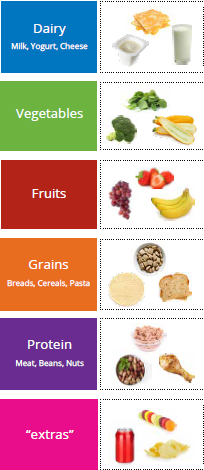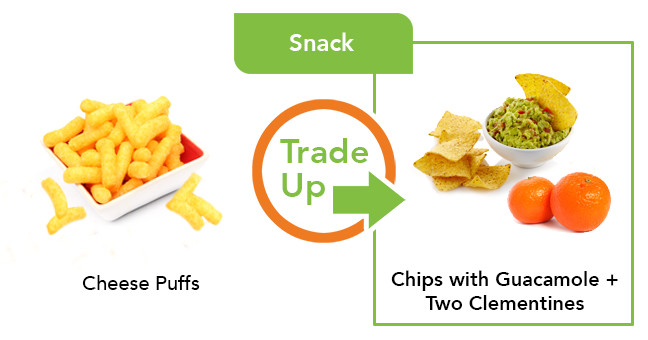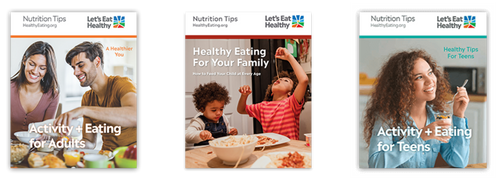Small steps to build healthier habits


Healthy eating is a pattern of nutritious and wholesome food choices that you make over time. Nutritious foods are nutrient dense, full of vitamins and minerals. Eating foods from a variety of food groups is a good way to balance food choices. Try to include items from two food groups at every snack and from three to five food groups at every meal.
Click on each of the 5 food group links to learn more:
Fats and oils also contain nutrients that are an important part of a healthy eating pattern. Dietary fats are found in both plant and animal foods. They supply calories for energy and help with the absorption of fat-soluble vitamins. Fats from food sources also protect organs, regulate body temperature and help produce hormones.
All the foods that you eat work together to impact health. Foods to build into daily choices for a healthy eating pattern include fruit, vegetables, milk, yogurt, cheese, whole grains, beans, nuts, seeds, fish, lean meat, poultry, eggs and healthy fats and oils.
Food labels are full of information to help you make decisions. Here are 3 tips for using a label:
Choosing the right amount and the right balance of foods to feel full and satisfied is a skill that can be developed. Learning to read a food label and estimating portion sizes are two ways to practice this skill. Estimating portion sizes can also reduce food waste.
The Nutrition Facts label can be a great tool to inform healthy eating decisions, but it is important to look beyond the label as well. Since you eat different combinations of foods over time rather than nutrients in isolation, choosing a variety of nutritious foods is more important than focusing on a single substance such as a vitamin, calories or sugar.
Habits take time to build. Practice making daily choices to move toward a healthier lifestyle.
 Try a few small steps to help achieve your health and nutrition goals. Here are some examples:
Try a few small steps to help achieve your health and nutrition goals. Here are some examples:
 Beverage choices matter. Beverages can be nourishing; however, be aware of empty-calorie beverage choices that contribute to total daily calories without a lot of nutrition.
Beverage choices matter. Beverages can be nourishing; however, be aware of empty-calorie beverage choices that contribute to total daily calories without a lot of nutrition.
Beverage choices are especially important for young children. Research shows that what children drink from birth through age 5 can have a significant impact on their health since beverages are a big part of what they consume during this critical life stage. New recommendations by health care professionals include plain water for hydration and plain pasteurized milk for nutrition. A limit on 100% juice consumption and limits or restrictions on added sugars in beverages are recommended.
 Physical activity is an important part of a healthy lifestyle. The benefits of regular movement include:
Physical activity is an important part of a healthy lifestyle. The benefits of regular movement include:
Physical activity can be in the form of exercise (jogging, walking, swimming) or everyday activities (gardening, car washing, stair climbing). Do it all at once or break it into increments of 10 to 20 minutes.
Being active 30 minutes per day, five days a week keeps the heart strong. To help with weight loss goals or maintenance, be active 60 to 90 minutes most days.
 Exercise should keep the heart beating fast for a period of time. Strength training exercises like lifting weights or doing push-ups, sit-ups or yoga are also important since they build muscle, improve balance and strengthen bones.
Exercise should keep the heart beating fast for a period of time. Strength training exercises like lifting weights or doing push-ups, sit-ups or yoga are also important since they build muscle, improve balance and strengthen bones.
No time for physical activity?
 As a parent or caregiver, you can influence a healthy lifestyle for the whole family. Here are some ways to support positive eating experiences that support a child’s health now and in the future:
As a parent or caregiver, you can influence a healthy lifestyle for the whole family. Here are some ways to support positive eating experiences that support a child’s health now and in the future:
 Small, daily lifestyle changes can lead to better health in the future. To get started, keep a food or activity diary for a week, then evaluate to see if you are eating a variety of foods from the food groups. For some people the simple act of writing
what they eat and drink improves the quality of their choices.
Small, daily lifestyle changes can lead to better health in the future. To get started, keep a food or activity diary for a week, then evaluate to see if you are eating a variety of foods from the food groups. For some people the simple act of writing
what they eat and drink improves the quality of their choices.
For information on label reading, food groups, activity and more, download the Activity + Eating for Adults, Healthy Eating for Your Family and Activity + Eating for Teens self-instructional booklets.
Megan Holdaway, RDN, discusses how you can build a foundation for healthy eating habits.
Watch hereDiscover the Activity + Eating booklet for information on label reading, food groups and more!